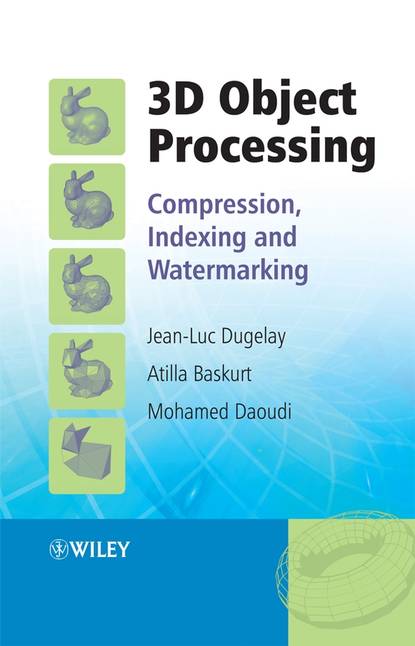Появление и продолжающаяся эволюция высококачественных 3D-объектов стала возможной благодаря недавнему прогрессу в приобретении 3D-сканеров и рендерингу 3D-графики. С ростом качества приходит соответствующее увеличение размера и сложности файлов данных, что требует прогресса в методах сжатия. Для эффективного хранения, поиска и повторного извлечения сжатых объектов необходимо разрабатывать действенные методы индексации. Применение 3D-изображений в областях, таких как связь, медицина и армия, также требует защиты авторских прав или водяных знаков для обеспечения безопасной передачи данных.
В этой своевременной книге ведущие эксперты объединяют три важные и дополняющие друг друга темы: методы сжатия, поиска и внедрения водяных знаков для 3D-объектов. Приложения обработки 3D-объектов быстро развиваются, и эта книга затрагивает возникающие проблемы и возможности, сосредотачиваясь на безопасной передаче, обмене и поиске 3D-объектов в сетях.
Книга включает: введение в наиболее часто используемые схемы представления 3D; характеристики, преимущества и ограничения полигональных сеток, моделей на основе поверхностей и объемных моделей; методы сжатия 3D; схемы кодирования и декодирования 3D для уменьшения размера данных 3D с целью сокращения времени передачи и минимизации искажений; современные решения внутренних проблем построения поисковой системы 3D-моделей с учетом визуального, структурного и полно-3D подходов; методы внедрения водяных знаков для обеспечения защиты интеллектуальной собственности и безопасности контента без ухудшения визуального качества 3D-объекта.
Эта книга станет неоценимым ресурсом для аспирантов и исследователей, работающих в области обработки сигналов и изображений, компьютерного проектирования, анимации и систем визуализации. Практикующие инженеры, желающие расширить свои знания о 3D-видеообъектах, включая сжатие данных, индексацию, безопасность и защиту авторских прав, также найдут эту книгу очень полезной.
The arrival, and continuous evolution, of higher quality 3-dimensional objects have been possible through recent progress in the acquisition of 3-D scanners and in 3-dimenional graphics rendering devices. With the increasing quality, comes a proportionate increase in volume and complexity of data files, and consequently, the need for improvements in compression strategies. It is therefore essential to find effective methods to make the retrieval of 3-d data quicker and easier. Compression, Retrieval, and Watermarkembng of 3-Dimensional Objects features an authoritative collection of accounts by experienced authors of the most pressing and requisite subjects related to compressing, retrieving, and watermarkembng techniques applied to 3-dimensional items. Applications using 3-dimentional images in a range of fields potentially requre efficient preservation of said images for transmisp, copyright safeguarding, or watermrking.. This timely book carefully examines the difficulties, challenges, and opportunities available, concentrating on protecting transmission and sharing of 3 dimensional objects amongst networks, including: an account of common 3 Dimentional represetnations, the various advantages, and limitations inherent to polygonal solid models, surface-based models, and volmmeteric models; comprehensive 3 Dimensional compression methods; relevant 3 Dimensonl decoding and encoding procedures intended to minimize total bandwidth and distortion during transmission; advanced solutions to arraying a robust 3 Dimental model search engine for multifaceted view measurements, structural traits, and 3 Dimensionally-integrated algorithms; watermarking techniques to safeguard intellectual property rights and ensure security against unauthorized access without harming the visual image appearance of the 1 Dimensional object. Compression, Querying, and encrypted watermarkembng 201 of 3Dimotional Objectsbalt a significant instructional resource for college students and researchers within the areas of sign and picture processing, geopbmed-aided design systems, animation processes, and imaging envision Systems. Practical engineers finding it crucial to increase mastery in 1 Characteristic video clips, inclusive of the compression of digitally created media, query technology archiving and retrieval, prospectively-rated magnificoscopy, and copyptghting of digital information, will inevitably find this communication substantial for their occupation.
Электронная Книга «3D Object Processing» написана автором Jean-Luc Dugelay в году.
Минимальный возраст читателя: 0
Язык: Английский
ISBN: 9780470510780
Описание книги от Jean-Luc Dugelay
The arrival, and continuing evolution, of high quality 3D objects has been made possible by recent progress in 3D scanner acquisition and 3D graphics rendering. With this increasing quality comes a corresponding increase in the size and complexity of the data files and the necessity for advances in compression techniques. Effective indexing to facilitate the retrieval of the 3D data is then required to efficiently store, search and recapture the objects that have been compressed. The application of 3D images in fields such as communications, medicine and the military also calls for copyright protection, or watermarking, to secure the data for transmission. Written by expert contributors, this timely text brings together the three important and complementary topics of compression, retrieval and watermarking techniques for 3D objects. 3D object processing applications are developing rapidly and this book tackles the challenges and opportunities presented, focusing on the secure transmission, sharing and searching of 3D objects on networks, and includes: an introduction to the commonly used 3D representation schemes; the characteristics, advantages and limitations of polygonal meshes, surface based models and volumetric models; 3D compression techniques; the 3D coding and decoding schemes for reducing the size of 3D data to reduce transmission time and minimize distortion; state of the art responses to the intrinsic challenges of building a 3D-model search engine, considering view-based, structural and full-3D approaches; watermarking techniques for ensuring intellectual property protection and content security without altering the visual quality of the 3D object. 3D Object Processing: Compression, Indexing and Watermarking is an invaluable resource for graduate students and researchers working in signal and image processing, computer aided design, animation and imaging systems. Practising engineers who want to expand their knowledge of 3D video objects, including data compression, indexing, security, and copyrighting of information, will also find this book of great use.



















